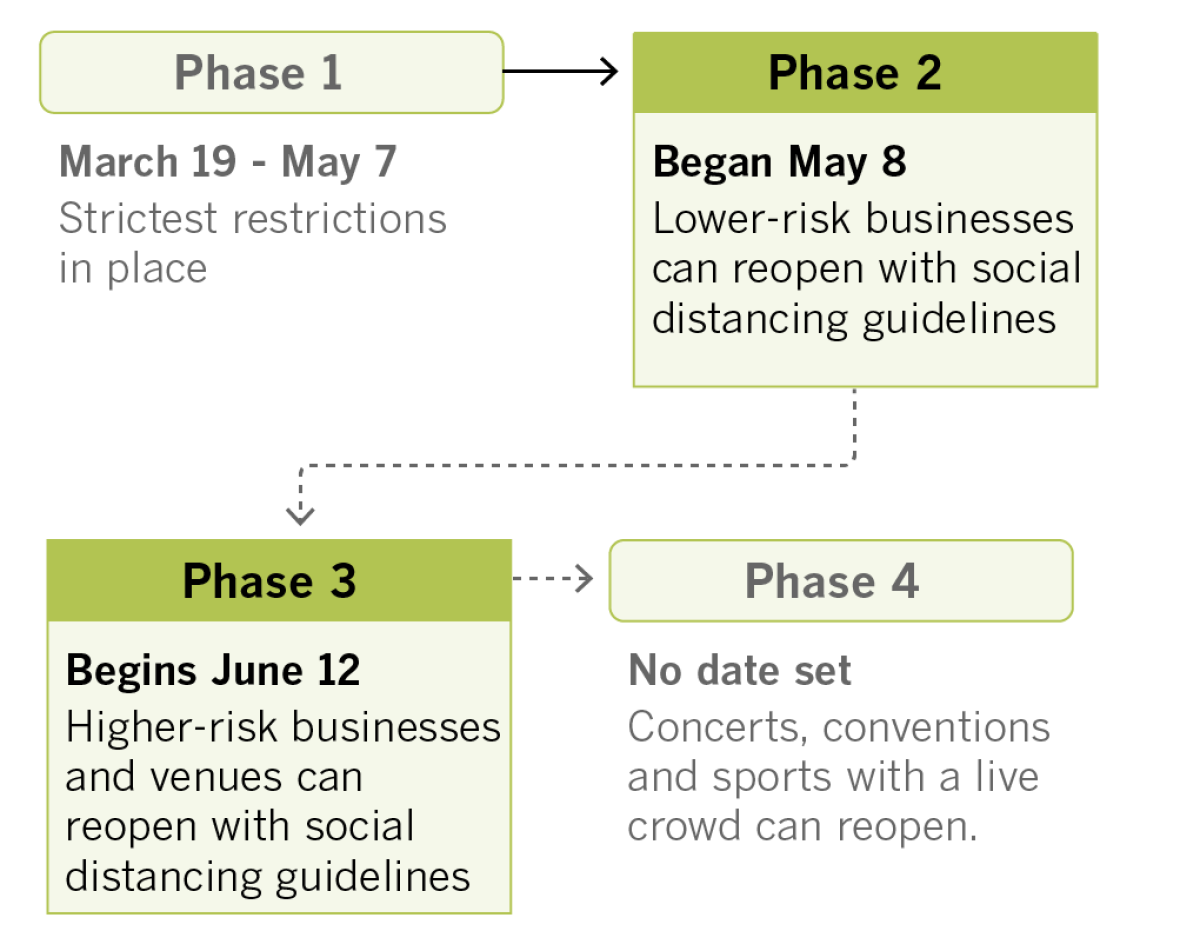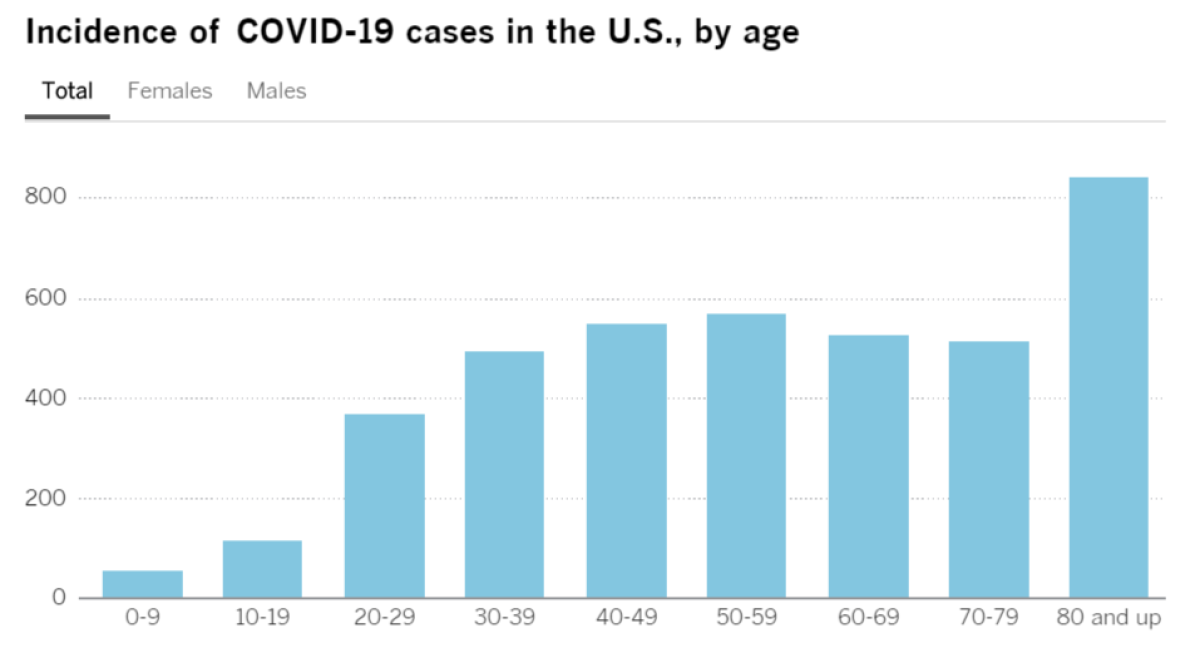Coronavirus Today: The risk of not wearing a mask
- Share via
Good evening. I’m Diya Chacko, and it’s Tuesday, June 16. Here’s what’s happening with the coronavirus in California and beyond.
As California’s businesses reopen, public health officials are keeping a watchful eye on them to make sure they’re following safety protocols. What they’ve seen so far isn’t encouraging.
In downtown San Diego, the crowds of unmasked customers waiting to enter newly opened bars last Friday prompted the county to issue a public health warning. And upon visiting roughly 2,000 restaurants in Los Angeles County over the weekend, officials there found around half were not in compliance with local guidelines.
Then there was the illegal, underground dance party thrown in a South L.A. warehouse Friday night.
The event organizers were discreet about advertising the show, knowing that they lacked permits — concerts and music venues are still prohibited from opening under state and local rules. But they did advertise online with contact information, and anyone over 21 could buy a $20 pass to attend.
Even public health professionals who were sympathetic to the recent protests against police brutality saw an indoor party as a head-spinning gamble. “Being in a small enclosed area in close contact with many others is one of the highest-risk activities one can do,” said a Kent State epidemiologist.
After allowing bars and nightclubs to reopen a month ago, Arizona is now seeing the consequences of failing to require masks and enforce social distancing rules and allowing patrons to pack public venues. Confirmed cases have soared, and the state is now a national hot spot for new infections — a major backslide for a state where it had earlier seemed the disease had largely been contained. “It’s squandering the sacrifices people made,” said the executive director of the Arizona Public Health Assn.
Health experts are finding that masks may be our best protection against the coronavirus. Read more about this in the “Your questions answered” section of this newsletter.
By the numbers
California cases and deaths as of 3:30 p.m. PDT Tuesday:
Track the latest numbers and how they break down in California with our graphics.

See which counties are reopening with our tracker.
Consider subscribing to the Los Angeles Times
Your support helps us deliver the news that matters most. Become a subscriber.
Across California
With a budget deadline approaching, Gov. Gavin Newsom and the California Legislature haven’t been able to agree on a spending plan. The main sticking point is whether a portion of the state’s budget deficit — estimated at $54.3 billion — will be erased by billions of dollars in new coronavirus assistance yet to be approved by Congress and President Trump. In the event of a federal stalemate, lawmakers want to soften the blow by tapping more of the state’s substantial cash reserves.
As each university in the 10-campus UC system prepares to release reopening plans, UCLA announced that the vast majority of its fall classes will be virtual, with only a small percentage offered on campus. In addition, UCLA will take steps to make on-campus housing less dense by prioritizing housing offers based on factors such as financial need and distance from students’ primary residence.
The state prison system is still grappling with major outbreaks; at least 3,219 incarcerated people have been confirmed to be infected. And two inmates from the California Institution for Men in Chino died recently from complications related to COVID-19, bringing the total number of deaths tied to that facility to 15.
The Rose Bowl is facing an uncertain financial future, with as much as $20 million in revenue lost due to the pandemic. It’s still in debt from its costly remodel in 2015 and 2016, and with competition from the new SoFi Stadium in Inglewood, the Southern California landmark still could be deep in the red by this time next year — even with millions in stop-gap funding from the city of Pasadena. “We were not planning on COVID, for sure,” said its general manager. “It came at a challenging time.”
Resources
— For general safety, wash your hands for at least 20 seconds (here’s a super-fun how-to video). Stop touching your face, and keep your phone clean. Practice social distancing, maintaining a six-foot radius of personal space in public. And wear a mask if you leave home. Here’s how to do it right.
— Watch for symptoms including fever, cough, shortness of breath, chills, repeated shaking with chills, muscle pain, headache, sore throat and loss of taste or smell. If you’re worried you might be infected, call your doctor or urgent care clinic before going.
— Here’s how to care for someone with COVID-19, from monitoring their symptoms to preventing the virus’ spread.
— If your job has been affected by the coronavirus pandemic, here’s how to file for unemployment.
— Here are some free resources for restaurant workers and entertainment industry professionals having trouble making ends meet.
— Advice for helping kids navigate pandemic life includes being honest about uncertainties, acknowledging their feelings and sticking to a routine. Here’s guidance from the CDC.
— In need of mental health services? Here are resources for coping during the crisis from the CDC and the L.A. County Department of Public Health. L.A. County residents can also call (800) 854-7771 or text “LA” to 741741.
Around the nation and the world
More than 116,700 people in the U.S. have died of COVID-19, more than the number of Americans killed in World War I. A new report from the Centers for Disease Control and Prevention offers the most comprehensive look to date at how Americans have been affected by the virus, based on more than 1.3 million patients who became sick in the U.S. between Jan. 22 and May 30. Take a look at six charts that break down the results by age, race and ethnicity and whether or not patients had underlying health conditions.

Researchers in England say they have the first evidence of a drug improving chances of COVID-19 survival: A cheap, widely available steroid called dexamethasone reduced deaths by up to one-third in severely ill hospitalized patients. While the drug did not appear to help patients with lesser symptoms — and could be dangerous for those with only mild infections — it was “an extremely welcome result” for those sick enough to require oxygen treatment, said the leader of the study.
An estimated 41 million Americans have filed for unemployment benefits since the pandemic began, according to the U.S. Department of Labor. But the wealthy have kept their assets, more or less, and they’re still spending tens of thousands of dollars on high-end jewelry. Retailers have attributed the demand to a combination of boredom and a desire for diversions and investment vehicles. “They can’t go on their world trip, so they will buy jewelry,” said the cofounder of New York jewelry company Roberto Coin.
Your questions answered
Today’s question comes from readers who want to know: How important is it to wear a face mask, really? Reporter Ron Lin found it’s even more important than first thought.
In some parts of California, the idea of mandatory face coverings has become the subject of intense political debate. Yet some of the nation’s top infectious disease and epidemiology experts say universal mask-wearing is one of the only protections we have against the virus.
In countries where mask-wearing was more culturally accepted before the pandemic, residents have been spared the most severe stay-at-home orders or have moved out of that phase more quickly. A new study adds even more weight to their importance, finding that social distancing, quarantine and isolation aren’t enough.
In anecdotal evidence, even though two hairstylists at a salon in Missouri had the virus, no customers became infected — and scientists think it was because the stylists and their clients were wearing face masks.
Now some experts say masks are more important than social distancing. “If I had to choose one over another ... I’d choose masks,” said a UC San Francisco epidemiologist. “Remember, what we’re trying to do here is prevent people who are asymptomatically infected from transmitting.”
And claims that cloth face masks and surgical masks pose a danger to people’s oxygen levels are unfounded, experts say, noting that many people who work in hospitals wear them all the time. “There’s all sorts of conspiracy theories about low oxygen and high CO2 levels,” said a UCLA expert on infectious disease. “It’s really not an issue.”
Got a question? Our reporters covering the coronavirus outbreak want to hear from you. Email us your questions, and we’ll do our best to answer them. You can find more answers in our Frequently Asked Questions roundup and on our coronavirus roundup page.
For the most up-to-date coronavirus coverage from The Times, visit our homepage and our Health section, listen to our “Coronavirus in California” podcast and follow us on Twitter and on Instagram.





